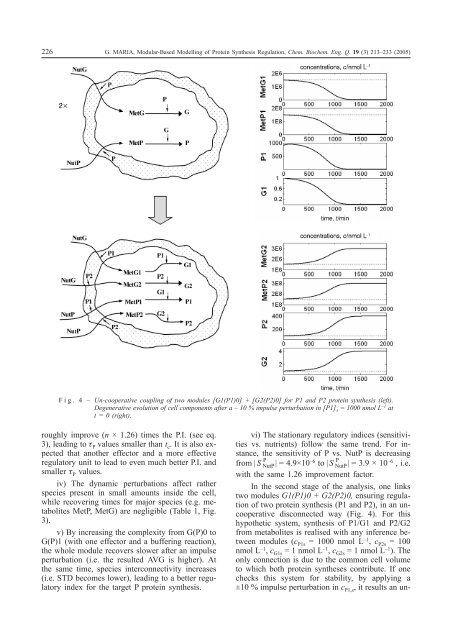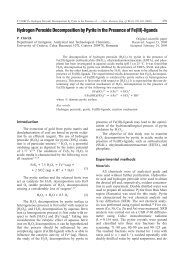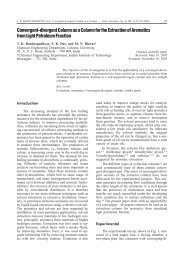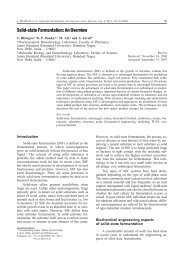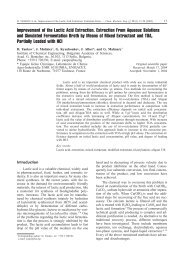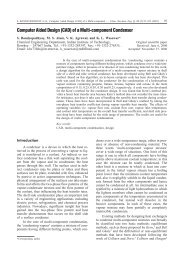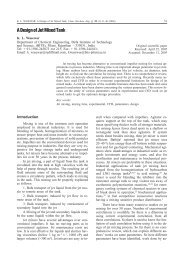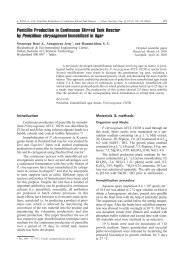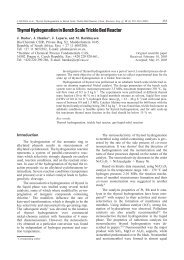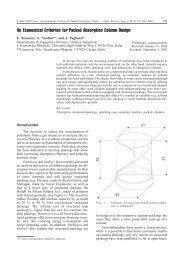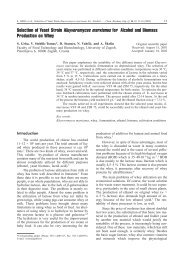Modular-Based Modelling of Protein Synthesis Regulation
Modular-Based Modelling of Protein Synthesis Regulation
Modular-Based Modelling of Protein Synthesis Regulation
Create successful ePaper yourself
Turn your PDF publications into a flip-book with our unique Google optimized e-Paper software.
226 G. MARIA, <strong>Modular</strong>-<strong>Based</strong> <strong>Modelling</strong> <strong>of</strong> <strong>Protein</strong> <strong>Synthesis</strong> <strong>Regulation</strong>, Chem. Biochem. Eng. Q. 19 (3) 213–233 (2005)<br />
Fig. 4 – Un-cooperative coupling <strong>of</strong> two modules [G1(P1)0] + [G2(P2)0] for P1 and P2 protein synthesis (left).<br />
Degenerative evolution <strong>of</strong> cell components after a – 10 % impulse perturbation in [P1] s = 1000 nmol L –1 at<br />
t = 0 (right).<br />
roughly improve (n × 1.26) times the P.I. (see eq.<br />
3), leading to P values smaller than t c . It is also expected<br />
that another effector and a more effective<br />
regulatory unit to lead to even much better P.I. and<br />
smaller P values.<br />
iv) The dynamic perturbations affect rather<br />
species present in small amounts inside the cell,<br />
while recovering times for major species (e.g. metabolites<br />
MetP, MetG) are negligible (Table 1, Fig.<br />
3).<br />
v) By increasing the complexity from G(P)0 to<br />
G(P)1 (with one effector and a buffering reaction),<br />
the whole module recovers slower after an impulse<br />
perturbation (i.e. the resulted AVG is higher). At<br />
the same time, species interconnectivity increases<br />
(i.e. STD becomes lower), leading to a better regulatory<br />
index for the target P protein synthesis.<br />
vi) The stationary regulatory indices (sensitivities<br />
vs. nutrients) follow the same trend. For instance,<br />
the sensitivity <strong>of</strong> P vs. NutP is decreasing<br />
P<br />
from | S NutP | = 4.9×10 –6 P<br />
to | S NutP | = 3.9 × 10 –6 , i.e.<br />
with the same 1.26 improvement factor.<br />
In the second stage <strong>of</strong> the analysis, one links<br />
two modules G1(P1)0 + G2(P2)0, ensuring regulation<br />
<strong>of</strong> two protein synthesis (P1 and P2), in an uncooperative<br />
disconnected way (Fig. 4). For this<br />
hypothetic system, synthesis <strong>of</strong> P1/G1 and P2/G2<br />
from metabolites is realised with any inference between<br />
modules (c P1s = 1000 nmol L –1 , c P2s = 100<br />
nmol L –1 , c G1s = 1 nmol L –1 , c G2s = 1 nmol L –1 ). The<br />
only connection is due to the common cell volume<br />
to which both protein syntheses contribute. If one<br />
checks this system for stability, by applying a<br />
±10 % impulse perturbation in c P1,s , it results an un-


